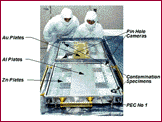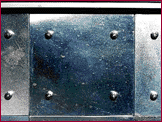



Objectives
The primary objectives of the PPMD Experiment were to measure impact fluxes and to identify sources of small orbiting debris that the Mir encounters. The debris impact fluxes on Mir are expected to be similar to the fluxes that will be encountered by ISS since Mir, like the ISS, is a large, frequently serviced, high inclination manned spacecraft. A secondary objective of the PPMD Experiment was to measure induced contamination that is deposited on surfaces near Mir.
Shuttle-Mir Missions Approach
http://setas-www.larc.nasa.gov/meep/30-day/ppmd/ppmd_30_day.html
Results
The unique contamination specimens mounted on the PPMD Experiment were magnesium fluoride, aluminum and Kapton. Contamination measurements were also made on the impact specimens. The Pin Hole Cameras recorded relative atomic oxygen flux directions to indicate the orientation of the impact specimens relative to the Mir velocity vector.
The small debris impact fluxes recorded by the PPMD Experiment are greater than current models predict and the fluxes are probably greater than the fluxes Mir experienced earlier in its mission. This increase in impact fluxes may be a result of the Shuttle missions to Mir that were flown while the PPMD Experiment was attached.
Specimens on one side of the PEC showed very little contamination (about 30 angstroms of silicone). The specimens mounted on the other side were visibly contaminated by liquid splashes. Chemical analysis of the contamination indicated that it was soapy water- probably a result of Shuttle waste water dumps performed while the Shuttle was docked to Mir. As a result of these observations, waste water dumps from the Shuttle will now be prohibited when it is docked to the ISS.
Earth Benefits Publications Principal Investigators Co-Investigators![]()
STS-76, NASA-2-NASA-5, STS-86
The PPMD Experiment was one of 4 experiments that made up the ISS Phase I Mir Environment Effects Payload (MEEP). The PPMD Experiment and the other 3 MEEP experiments (the Orbital Debris Collector, the Passive Optical Sample Assembly I and the Passive Optical Sample Assembly II Experiments) were transported to and from Mir, via the Shuttle, in 4 Passive Exposure Containers (PEC's). During EVA operations while the Shuttle was docked to Mir, the 4 PEC's were removed from the Shuttle cargo bay, attached to handrails on the Mir/Shuttle Docking Module and opened to exposure the experiment specimens to the near Mir environment. After an 18 month space exposure, the 4 PEC's were closed, removed from Mir, and replaced in the Shuttle cargo bay for the return trip, again during an EVA operation. After the Shuttle landed at the KSC on the retrieval mission, the PECs' were removed from the cargo bay and the PEC containing the PPMD Experiment was shipped to the Langley Research Center where the post retrieval impact and contamination analysis was done. Photographs and additional information regarding the PPMD Experiment can be found at the following Internet site:
The gold (Au), aluminum (Al) and zinc (Zn) plates were exposed to record craters resulting from debris impacts. The gold and aluminum specimens are identical to specimens exposed on the LDEF and thus allow direct comparisons of the impact fluxes recorded on LDEF with those recorded on the PPMD Experiment. The intent of this comparison was to determine if the flux of man-made orbiting debris increased as a result of the servicing vehicles. The zinc specimens were exposed in an effort to capture more of the impactor as residue in the craters and by so doing improve the chances that the debris composition and possibly it's source can be identified. It was thought that the low melting point of zinc may aid in the capture of debris fragments.
As the global community begins to rely more heavily on digital and electronic communications, Earth-orbiting structures like communications satellites have become increasingly important. These satellites provide pager, telephone, television, military intelligence, and news service around the world. Because of the great expense involved in placing such satellites in orbit, longevity is a necessity. In order to achieve such longevity, ways to enhance the external structure of satellites need to be developed.
By researching the types of particles, as well as the size and velocity of the particles that have encountered the Space Station Mir, it appears possible to identify ways to protect such objects against hypervelocity impacts in LEO. This includes laboratory studies to simulate impacts on new materials being considered for both the external structures of the International Space Station and new satellites. Second, it will be possible to verify previous mathematical models on the behavior and production of particles in the space environment. With such information at hand, new, more durable materials can be developed that will help protect spacecraft from possible catastrophic impacts, saving money, as well as lives.
None available at this time.
William H. Kinard
NASA/Langley Research Center
Donald H. Humes
Gale A. Harvey
![]()
|
|
Curator:
Julie Oliveaux
Responsible NASA Official: John Uri |
Page last updated: 07/16/1999
.gif)